Abstract
With the advancement of autonomous driving technology, transportation systems are inevitably confronted with mixed traffic flows consisting of connected and automated vehicles (CAVs) and human-driven vehicles (HDVs). Current research has predominantly focused on implementing homogeneous control strategies for ramp merging vehicles in such scenarios, which, however, may result in the oversight of specific requirements in fine-grained traffic scenarios. Therefore, a classified cooperative merging strategy is proposed to address the challenges of microscopic decision-making in hybrid traffic environments where HDVs and CAVs coexist. The optimal cooperating vehicle on the mainline is first selected for the target ramp vehicle based on the principle of minimizing time differences. Three merging strategies—joint coordinated control, partial cooperation, and speed limit optimization—are then established according to the pairing type between the cooperating and ramp vehicles. Optimal deceleration and lane-changing decisions are implemented using the average speed change rate within the control area to achieve cooperative merging. Validation via a SUMO-based simulation platform demonstrates that the proposed strategy reduces fuel consumption by 6.32%, NOx emissions by 9.42%, CO2 emissions by 9.37%, and total delay by 32.15% compared to uncontrolled merging. These results confirm the effectiveness of the proposed strategy in mitigating energy consumption, emissions, and vehicle delays.
1. Introduction
In the current management framework of urban transportation systems, a prominent issue is the lack of precision in control measures [1]. This situation directly leads to inefficient traffic operation and exacerbates the environmental impact of vehicle emissions. Faced with this challenge, the emergence of intelligent connected vehicle technology provides new opportunities for building a more sustainable transportation system, but it also comes with a series of pressing issues that need to be addressed [2]. With the continuous advancement of intelligent transportation technology, the traditional traffic flow pattern composed solely of human-driven vehicles (HDVs) is gradually transitioning to a new hybrid traffic flow pattern where HDVs and connected and automated vehicles (CAVs) coexist. Therefore, how to achieve efficient vehicle coordination and merging in highway ramp areas under this new hybrid traffic flow environment has become an important research target.
Regarding the safe merging of vehicles at highway ramps, scholars have conducted extensive research on merging guidance schemes and optimized cooperative control [3,4,5,6,7]. In the area of merging guidance schemes, rule-based methods are simple and efficient, but they perform poorly in optimizing merging sequences for complex scenarios. In summary, most current research focuses on models that minimize conflicts and optimize speed control, with the underlying premise of the connected environment [8,9]. However, as CAVs develop in the future, the mixed operation mode between HDVs and CAVs will gradually become prevalent. Secondly, most research on merging in mixed traffic flows implements a single lane-changing or deceleration decision without comparing the benefits of both to select the optimal execution method.
This study not only refines the overly idealized issues in existing research that neglect the characteristics of HDVs but also addresses the oversight of dual-option optimization in merging decisions, thereby establishing a typed vehicle merging decision-making method for safe and efficient merging of ramp vehicles onto highways. The primary contributions of this paper are as follows:
- (a)
- A merging control strategy framework is developed, which integrates multi-type vehicle control decisions through a scenario discrimination approach;
- (b)
- The speed control and lane-changing decisions of cooperating vehicles are collaboratively optimized;
- (c)
- Road traffic conditions were analyzed using various CAV penetration rates and implementing merging control strategies.
2. Literature Review
In recent years, with the rapid development of intelligent transportation systems and autonomous driving technology, the issue of vehicle merging at highway ramps, as a critical component of traffic flow management, has garnered considerable attention [10,11]. Vehicle merging not only directly impacts road traffic efficiency but also relates to traffic safety, driving comfort, and environmental sustainability [12]. In merging areas such as highway on-ramps, how to achieve coordinated merging among vehicles, reduce traffic congestion, and lower accident risks has become an urgent optimization hotspot [3,4].
In the early exploration of vehicle merging technology, I. A. Ntousakis et al. [13] conducted in-depth research on vehicle trajectory planning in the context of coordinated highway merging. By optimizing vehicle trajectories, they achieved smooth and efficient merging processes, providing a theoretical foundation for subsequent research on vehicle merging trajectory planning.
2.1. Rule-Based Merging Strategy
As intelligent transportation technology has advanced, the application of traffic flow management strategies in vehicle merging has gradually increased. R. Lagerev et al. [14] effectively reduced the likelihood of traffic congestion on highways through ramp control management strategies, demonstrating the potential of traffic flow control technology in alleviating traffic pressure. J. Sun et al. [15] further modeled and predicted random merging behavior at highway on-ramp bottlenecks, providing a scientific basis for understanding and optimizing mixed traffic flows. H. Pei et al. [16] proposed a ramp merging cooperative driving strategy based on dynamic programming, which reduces complexity and obtains a globally optimal passing sequence by defining state space and criterion functions, overcoming local optimum and suboptimal issues. L. Xu et al. [17] proposed a cooperative merging strategy for connected vehicles, improving merging efficiency by optimizing the relative positions and speeds between vehicles. J. Ding et al. [18] proposed a rule-based cooperative strategy that achieves a near-optimal merging sequence with minimal computational effort but only considered the case of 100% CAV penetration without considering HDVs.
In the research on the optimization of vehicle merging strategies, Kherroubi et al. [19] proposed a novel decision-making strategy for CAV merging at highway on-ramps, achieving a more intelligent and efficient merging process by considering interactions between vehicles and traffic flow states. Additionally, scholars have focused on the macroscopic traffic flow changes near ramps and the impact of vehicle merging on traffic flow, such as A. van Beinum et al. [20] analyzing macroscopic traffic flow changes near ramps, and J. Guo et al. [21] exploring the impact of conventional and autonomous vehicles on traffic flow during merging and diverging in mixed traffic. X. Han et al. [22] studied the strategic and tactical decision-making of cooperative vehicle platoons on multilane highways, providing new ideas for the coordination of vehicle platoons in merging areas.
Regarding the safety and reliability of vehicle merging, M. Kunibe et al. [23] proposed a scheduling scheme for CAV highway merging and conducted a fairness analysis, ensuring the safety of the merging process. X. Zhao et al. [24] assessed the cybersecurity risks of coordinated ramp merging in mixed traffic environments, providing important safeguards for the safe application of vehicle merging technology. Furthermore, W. J. Scholte et al. [25] proposed a control strategy for merging individual vehicles into platoons at highway on-ramps, further enhancing the safety and reliability of the merging process. Y. Xue et al. [26] proposed a platoon-based cooperative optimal control method for CAV merging under heavy traffic conditions at highway on-ramps, improving the traffic efficiency and safety of the merging process. H. Li et al. [27] developed an adaptive, personalized speed guidance system for merging at highway service area on-ramps and conducted a safety assessment, providing strong support for the practical application of vehicle merging technology.
In terms of social interaction behaviors and energy consumption issues during vehicle merging, H. Wang et al. [28] studied the social interactions of merging behaviors in congested traffic at highway on-ramps, providing new insights into understanding driver behavior. L. Yang et al. [29] analyzed the impact of speed trajectory optimization on energy consumption during highway merging processes, offering new strategies for energy conservation and emission reduction. Additionally, M. Aramrattana et al. [30] explored the impact of platoon spacing on conventional vehicle drivers in highway merging scenarios through simulation studies, providing a theoretical basis for optimizing platoon spacing.
2.2. Merging Strategy Based on Intelligent Algorithm
Driven by autonomous driving technology, research on vehicle merging strategies has entered a new phase [31,32,33]. J. Rios-Torres et al. [34] took the lead in proposing a coordinated vehicle merging approach, significantly improving merging efficiency and safety through communication and collaboration among vehicles. Their subsequent research [35] also delved into the collaboration between CAVs and HDVs at intersections and highway on-ramps, providing important references for the application of autonomous driving technology in the field of vehicle merging.
With the rise of technologies such as deep learning and reinforcement learning, their application in the field of vehicle merging has gradually become a research hotspot. H. Wang et al. [36] proposed an autonomous driving merging method based on deep reinforcement learning, which simulates and optimizes the vehicle merging process by training models, achieving intelligent coordination and efficient merging. N. Chen et al. proposed hierarchical model optimization control methods and optimal maneuver planning and trajectory control methods, further improving the traffic efficiency of vehicle merging [37,38]. Cheng et al. proposed an adaptive coordinated variable speed limit strategy based on deep reinforcement learning for speed coordination between highway mainlines and on-ramps, effectively alleviating traffic congestion [39].
Furthermore, scholars have conducted in-depth research on vehicle merging technology from various perspectives, including vehicle dynamics and traffic flow theory [40,41]. M. Pang et al. [42] proposed a cooperative control strategy based on an improved variable time headway for the merging of CAV platoons at highway on-ramps, enhancing the coordination and efficiency of the merging process. J. Shi et al. proposed a cooperative merging strategy based on an optimal final state phase diagram for mixed traffic environments, achieving flexible highway merging points [43].
2.3. Critical Review of Existing Research
In summary, most current research focuses on models that minimize conflicts and optimize speed control, with the fundamental premise being a purely connected environment. However, with the future development of CAVs, the mixed mode of HDVs and CAVs is gradually becoming prevalent [29,44,45,46]. Three primary limitations have been identified in existing research on merging strategies. First, homogeneous decision-making models have been predominantly developed without consideration of scenario-specific model selection based on traffic conditions. Second, coordination mechanisms between heterogeneous merging strategies are frequently overlooked. Finally, the evolution of traffic state characteristics under varying CAV penetration rates remains underexplored.
3. Problem Statement
This paper investigates the cooperative control strategy for highway ramp merging zones under mixed traffic conditions of CAVs and HDVs. The model developed in this study was specifically designed to address the inherent limitation of centralized merging strategies in dynamically adapting decision-making patterns to varying traffic scenarios. Initially, optimal cooperative vehicles were selected from mainline traffic for target ramp vehicles based on the minimum time difference principle. Subsequently, vehicle pairing types between the selected cooperative vehicles and target ramp vehicles were determined, followed by the establishment of scenario-specific merging strategies. Three distinct control modalities were implemented: (1) joint coordination control strategy, (2) partially cooperative merging strategy, and (3) dual-constrained velocity regulation strategy incorporating both neighboring vehicle interactions and ego-vehicle limitations.
The research scenario focuses on a two-lane mainline with an additional parallel acceleration lane merging with a single ramp, as illustrated in Figure 1. The following assumptions are made in this study: (1) information transmission between vehicles and roadside units (RSUs) is assumed to be instantaneous, with no delays considered in communication between RSUs; (2) relevant data of HDVs can be collected by RSUs within a short period of time. RSU-1 is positioned at the junction of the mainline and the ramp, while RSU-2 is located upstream of RSU-1. The coverage range R of the RSUs is set at 200 m, with RSU-1 specifically required to cover the entire acceleration lane (R = LA), aiming to capture the real-time dynamics of ramp vehicles within the acceleration lane. The definitions and explanations of parameters used in this paper are provided in Table 1.
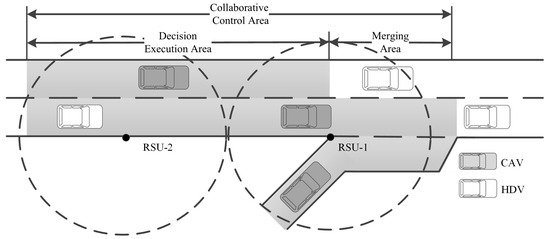
Figure 1.
Schematic diagram of research scenarios.

Table 1.
Parameter description.
4. Collaborative Control Strategy for Ramp Merging
This paper develops different merging strategies based on the pairing types of cooperative vehicles and ramp vehicles. The control strategy process is illustrated in Figure 2.
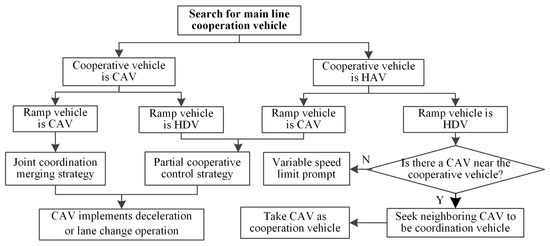
Figure 2.
Flow chart of cooperative strategy.
4.1. Optimal Cooperative Vehicle Selection
When ramp vehicles enter the control zone, the roadside unit searches for cooperative vehicles on the main road within the control area for them. The selection of cooperative vehicles follows the principles below:
- (1)
- The time difference Δt between the cooperative vehicle and the ramp vehicle arriving at the initial merging point o is minimized:
- (2)
- Priority is given to selecting a CAV. This criterion applies when the cooperative vehicle that satisfies Principle (1) is an HDV, but there are CAVs among its preceding and following neighboring vehicles. In this case, priority is given to selecting a CAV for coordination.
4.2. Joint Coordinated Merging Strategy
When the pairing type between the cooperative vehicle and the ramp vehicle is CAV-CAV, the control strategy process is illustrated in Figure 3.
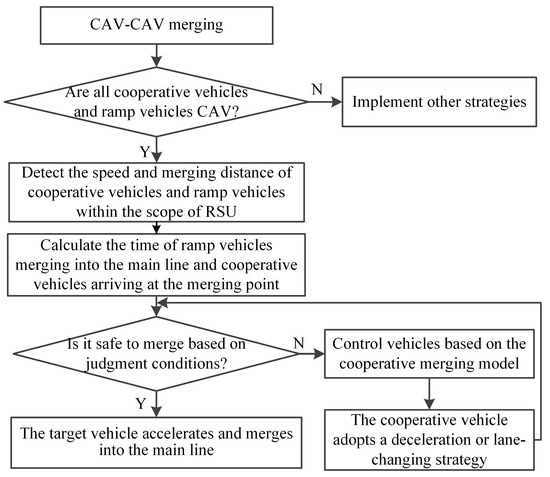
Figure 3.
Flow chart of joint coordinated merging strategy.
Step 1: Determining the need to control the cooperative vehicle.
After selecting the cooperative vehicle, it is determined whether control of the cooperative vehicle is necessary based on the time at which the cooperative vehicle and the ramp vehicle arrive at the initial merging point. When , a control strategy is implemented; when , it is necessary to assess whether the safety gap is satisfied (see Equation (2)).
In this paper, without considering driver-related behaviors, the selection of the IDM (Intelligent Driver Model) and CACC (Cooperative Adaptive Cruise Control) car-following models is based solely on vehicle type. Therefore, the minimum safe gap is determined according to different headways, as specified below:
where L represents the vehicle length, so denotes the safe distance under braking conditions, vi is the speed of the following vehicle, and T is the headway.
Step 2: Speed optimization/lane-changing strategy for cooperative vehicles.
- (1)
- Speed optimization strategy for cooperative vehicles.
As illustrated in Figure 4, at time t0, vehicle r initiates a service request, at which point the optimal vehicle m is selected for collaboration. Their respective positions at this time are xr(t0) and xm(t0). Assuming that section p represents the pre-merging lane identified by the algorithm where merging can commence, with a position of x, the shaded area in the diagram denotes the collaborative operation zone for the cooperative vehicle and the ramp vehicle.
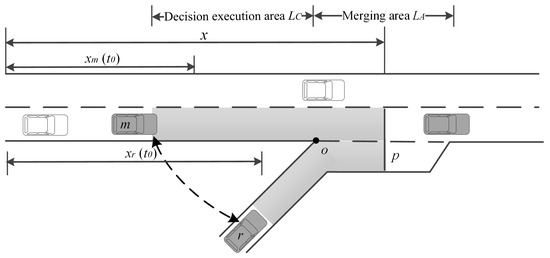
Figure 4.
Schematic diagram of operable section of cooperative vehicle (CAV-CAV).
For ramp vehicles, they travel at their initial speed on the ramp and accelerate at an acceleration rate (taken as 1.5 m/s2) on the acceleration lane, satisfying Equation (4).
For cooperating vehicles on the mainline, upon receiving a service request, they begin to decelerate at a deceleration rate (represented numerically herein, without considering the negative sign), satisfying Equations (5) and (6).
To ensure effective coordination between the cooperating vehicle and the ramp vehicle, it is desired that when the ramp vehicle accelerates to vmerge at the acceleration rate , the distance between the two vehicles is greater than Ss (see Equations (7) and (8)).
where
Constraint conditions: Considering factors such as the speed limit on the mainline lane, the gap between the ramp vehicle and the preceding cooperating vehicle on the mainline, the length of the acceleration lane, and the influence of leading vehicles, the comprehensive constraint conditions are as follows:
In summary, the range of acceleration time can be obtained as Equation (10).
where
By synthesizing Equations (4)–(11), the range of merging speeds is obtained, and subsequently, the range of deceleration rates for the cooperating vehicle is determined. On the mainline road, to ensure the safety and comfort of vehicle travel, the optimal deceleration rate a* for the cooperating vehicle is determined as .
- (2)
- Lane change strategy for cooperating vehicles.
When the two lanes on the mainline meet the conditions for lane changing, the cooperating vehicle is controlled to switch from mainline lane 1 to lane 2, providing a larger merging gap for the target vehicle, as shown in Figure 5.
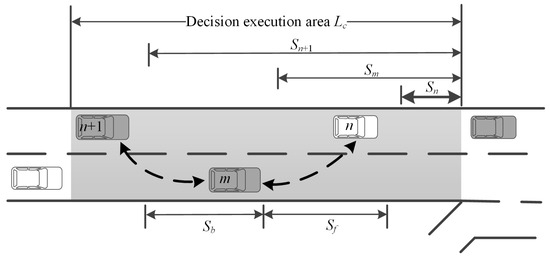
Figure 5.
Schematic diagram of coordinated lane change decision.
When , regardless of vehicle type, the lane change maneuver can be executed.
When , if both the lateral preceding and following vehicles are HDVs, the lane change maneuver is aborted; if there is a CAV among the lateral preceding and following vehicles, coordinated speed control is implemented to reserve a lane change gap:
- (a)
- If vehicle n is a CAV and vehicle n + 1 is an HDV, then coordinate and collaborate with vehicle n to search for accelerations and that satisfy the target conditions (see Equation (12)).
The constraint conditions are as follows:
Based on the value range of , the tm value that meets the target conditions is obtained. From the tm value, the minimum of that satisfies the target is determined, thereby determining .
- (b)
- If vehicle n + 1 is a CAV and vehicle n can be of any type, control of the lateral preceding vehicle is not considered. Instead, the cooperating vehicle and the lateral following vehicle are coordinated to decelerate, ensuring that while maintaining a safe distance from the lateral following vehicle, the distance from the lateral preceding vehicle is gradually increased to satisfy the target conditions (12).
The comprehensive constraint conditions are as follows:
Based on the value range of , the tm value that meets the target conditions is obtained. The tm value corresponds to a unique , and ultimately, the minimum of that satisfies the target is calculated, thereby determining .
Step 3: Dual-scheme optimization decision-making by the cooperating vehicle.
When a ramp vehicle initiates a service request and the optimal cooperating vehicle is identified for it, the speed of the i-th vehicle within the control zone is denoted as . After implementing the corresponding control strategy, whether it be speed adjustment or lane change, the speed of the i-th vehicle within the control zone becomes . Here, represents the lane, with 0, 1, and 2 indicating the ramp, main lane 1, and main lane 2, respectively, and denotes the time taken from the initiation of the maneuver to the merging point.
The determination of primarily relies on the deceleration and speed sought by the cooperating vehicle, following the acceleration and deceleration profiles established by car-following behavior to predict . The average speed change rate within the control zone, , is determined by Equation (15).
When calculating the average speed change rate of vehicles, the impacted vehicles are monitored on a per-lane basis. Therefore, the total change rate for vehicles in each scheme is given by Equation (16).
Comparing the total change rates of the two schemes, the one with the minimum average speed change rate within the control zone is selected as the optimal scheme for implementation.
4.3. Partial Cooperative Merging Strategy
In pairing types between cooperating vehicles and ramp vehicles where only one vehicle is a CAV, due to the uncertainty in HDV driving behavior, control of the CAV is necessary. The specific control process for the CAV is illustrated in Figure 6.
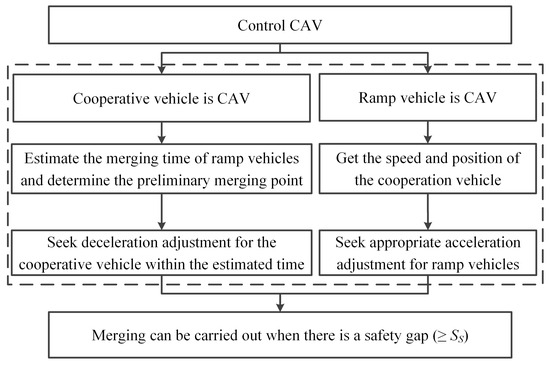
Figure 6.
Flow chart of partial collaborative merging strategy.
- (1)
- Mainline CAV-Ramp HDV
In this scenario, the ramp vehicle’s behavior on the acceleration lane is predicted based on its following acceleration, and relevant data are obtained.
The ramp vehicle continues to travel at its original speed on the ramp and accelerates at acceleration on the acceleration lane, satisfying Equation (17).
Upon receiving the service request, the cooperating vehicle begins to decelerate at a deceleration , satisfying Equations (5) and (6). When the ramp vehicle accelerates at an acceleration for to prepare for merging, the gap between the two vehicles meets the safety distance criteria, as shown in Equation (7).
Constraints:
The deceleration for the cooperating vehicle is selected. Since the cooperating vehicle is of the CAV type, it is still controlled to perform cooperative lane changing in the decision-making and execution zone. The optimal strategy is chosen by comparing the benefits of lane changing and deceleration. This process is consistent with steps 2 and 3 described in Section 4.1 and is not elaborated further.
- (2)
- Mainline HDV-Ramp CAV
In this scenario, if there is a CAV adjacent to the optimal cooperating vehicle that can serve as a secondary optimal cooperating vehicle (alternate cooperating vehicle) for coordination, the cooperating vehicle is changed, and a joint CAV-CAV coordinated control operation is implemented. However, if no such vehicle exists, a suitable acceleration for the ramp vehicle is sought based on information such as the speed and position of the HDV cooperating vehicle obtained by the RSU.
This method is similar to the joint coordinated control strategy, but the difference lies in the fact that the cooperating vehicle is an HDV, and relevant information needs to be predicted and estimated. Additionally, the HDV cannot receive information from CAVs, creating uncontrollable conditions. Therefore, after obtaining the deceleration of the cooperating vehicle, speed warnings are provided through in-vehicle devices and variable speed limit signs, indicating the merging speed (target deceleration speed) and the distance to the prepared merging point to guide the driver in performing the relevant operations. In this case, the lane-changing strategy for the cooperating vehicle is not implemented; only the speed control strategy is adopted.
4.4. Seeking Speed Limit Strategy for Adjacent and Self-Owned Vehicles
When both the cooperating vehicle and the ramp vehicle are HDVs, the specific execution mode is shown in Figure 7.
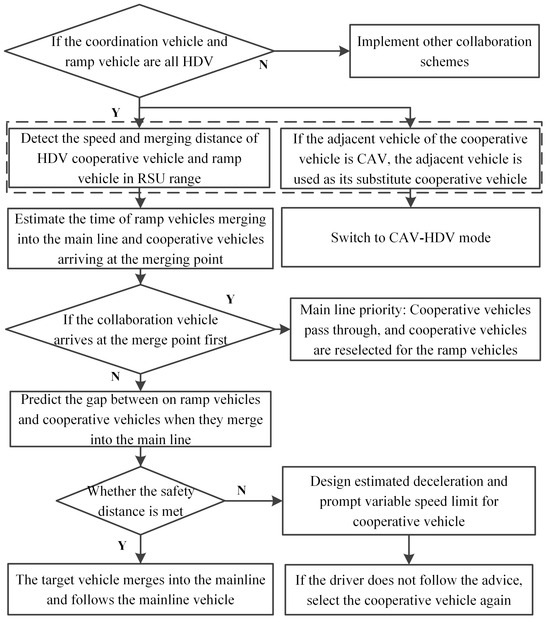
Figure 7.
Flow chart of seeking speed limit strategy for adjacent and self-owned vehicles.
The position where the ramp vehicle accelerates to at the acceleration lane with a following acceleration is designated as the preliminary merging point. For the cooperating vehicle (HDV) on the main road, it is necessary to first determine whether the cooperating vehicle reaches the dangerous zone (i.e., whether the safety gap is maintained) at its current speed within the time it takes for the target vehicle to complete its acceleration and merge. There are primarily three scenarios:
- (1)
- If the cooperating vehicle reaches the merging point first, following the rule of main road priority, the HDV cooperating vehicle passes, and a new cooperating vehicle is selected for the target vehicle.
- (2)
- If the ramp vehicle reaches the merging point first and the safety gap is satisfied, the ramp vehicle merges.
- (3)
- If the ramp vehicle reaches the merging point first but the safety gap between the two is not satisfied, the HDV-HDV mode is implemented.
In the HDV-HDV mode, the target ramp vehicle continues to travel at its original speed on the ramp and accelerates at the acceleration lane with the following acceleration . Since both the cooperating vehicle and the ramp vehicle are HDVs, the ramp vehicle exhibits a desire to merge onto the main road when it accelerates to the minimum speed limit of the main road while on the acceleration lane. Therefore, to reduce errors arising from predictive information, it is stipulated that the merging speed in this mode is set to , the minimum speed limit of Lane 1 on the main road. That is, the ramp vehicle changes lanes and merges when it accelerates to , satisfying Equation (19).
For the cooperating vehicle on the main road, the deceleration is estimated based on the collected information:
It is expected that the gap between the two vehicles meets the safety criteria when the ramp vehicle accelerates from acceleration to . The target condition is
Constraint:
The deceleration of the cooperating vehicle is obtained, and the merging speed (target deceleration speed), along with the distance to the preliminary merging point, is used to issue speed warnings through in-vehicle devices and variable speed limit signs.
5. Results
5.1. Experimental Design
Simulation evaluations were conducted using the traffic simulator SUMO. The algorithm was solved using Python 3.10.5 programming software and integrated into the simulation environment. The study scenario, as illustrated in Figure 1, comprises a 400 m decision control zone and a 200 m merging zone (acceleration lane). The IDM and Lane-Changing Model 2013 (LC2013) were employed for car-following and lane-changing behaviors, respectively. The IDM was implemented to simulate longitudinal vehicle-following dynamics through acceleration patterns regulated by inter-vehicle spacing and velocity differentials. Additionally, the LC2013 was employed to govern lateral maneuvering decisions based on gap acceptance thresholds and traffic incentive structures. Vehicle types included CAVs and HDVs.
A stochastic integration of CAVs and HDVs was implemented in the merging scenario. The parameters of the car-following model were systematically calibrated, with vehicle control operations executed through SUMO’s Traci API interface. Detailed experimental configuration parameters are documented in Table 2.

Table 2.
Simulation parameters for merging decisions.
5.2. Results Analysis
Initially, random traffic flow was input on the highway, as depicted in Figure 8, where ramp vehicles were CAVs, and lanes 1 and 2 of the main road contained randomly typed vehicles. When a ramp vehicle r entered the coordinated control area and initiated a service request, the optimal cooperative vehicle was selected to execute relevant control operations. In this simulation scenario, the optimal cooperative vehicle, m3, was determined based on the speed of the ramp vehicle upon entering the control zone, its distance from the merging point, and the time to reach the initial merging point.
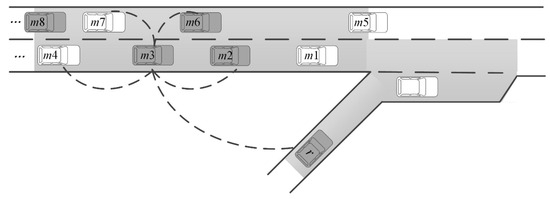
Figure 8.
Joint coordination and control scenario.
Since the aforementioned combination is of the CAV-CAV type, and the optimal speed optimization decisions have been identified through algorithmic analysis for both scenarios, a joint coordinated speed control strategy is adopted. The following analysis examines the efficiency of this strategy in comparison to other strategies.
Figure 9 illustrates vehicle positions without control and with the implementation of speed reduction control and lane-changing control. As shown in Figure 9a, when no control is applied, the ramp vehicle and the cooperating vehicle m3 reach the preliminary merging point almost simultaneously, leading to a significant conflict. The ramp vehicle cannot merge at the preliminary merging point and must wait for an opportunity. Figure 9b presents the vehicle trajectories after the implementation of speed reduction control. Due to the early deceleration of the cooperating vehicle, a safe lane-changing space is reserved for the ramp vehicle in main lane 1, allowing the ramp vehicle to merge directly into the main line upon reaching the preliminary merging point. Figure 9c depicts the vehicle trajectories after the implementation of lane-changing control. Although the ramp vehicle and the conflicting vehicle m3 are staggered in their arrival times at the merging point, the distance between the two vehicles is smaller compared to the distance under speed reduction control in Figure 9b, failing to meet the safety distance requirement and resulting in poorer safety.
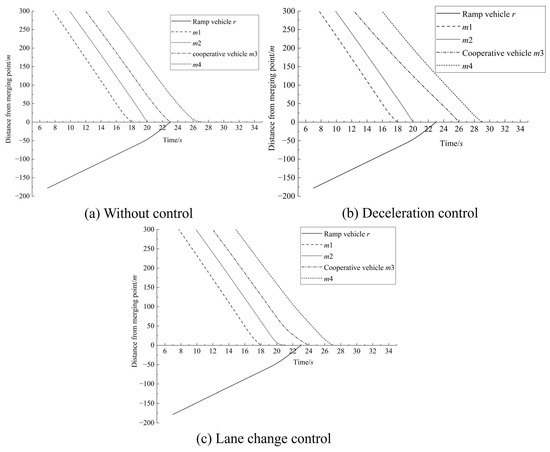
Figure 9.
Comparison diagram of vehicle position under different control: (a) without control; (b) deceleration control; (c) lane change control.
The impact of ramp vehicle merging on subsequent traffic flow is shown in Figure 10. Without control, the average speed of subsequent vehicles varies significantly, with a fluctuation range of 14 m/s to 28 m/s. This indicates that the merging of ramp vehicles without control causes significant interference with subsequent traffic flow. After implementing speed reduction control, the average speed of subsequent traffic flow changes less, with a fluctuation range of 24 m/s to 28 m/s. This is because the early and gradual deceleration of the cooperating vehicle leads to a normal deceleration phase for subsequent traffic flow before reaching the preliminary merging point, resulting in a smaller impact. After implementing lane-changing control, the average speed of subsequent traffic flow fluctuates between 21 m/s and 28 m/s. Compared to the changes in average speed under no control conditions, there is an improvement, but the fluctuation is not significantly different from that under speed reduction control, and there is a gradual deceleration phase. Therefore, speed reduction control performs better in terms of traffic efficiency and has a smaller impact on the degree of interference.
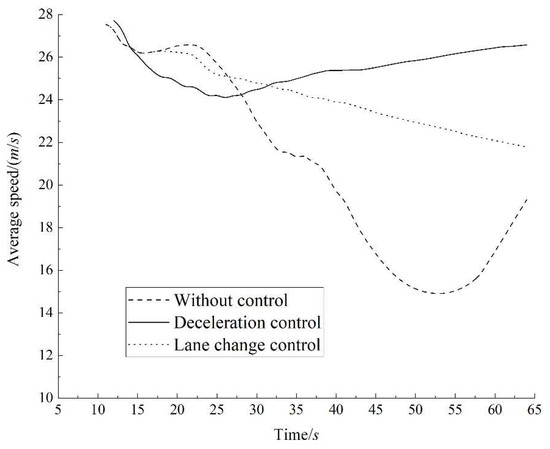
Figure 10.
Comparison of average speed of subsequent traffic flow under different controls.
The changes in the average acceleration of subsequent vehicles are shown in Figure 11. In the comparison chart of subsequent traffic flow acceleration changes, the average acceleration range of vehicles under no control conditions is from −0.5 m/s2 to 0.7 m/s2, with significant fluctuations and extremely poor safety and comfort. After speed reduction control, the average acceleration range of vehicles is from −0.2 m/s2 to 0.1 m/s2, with stable fluctuations around 0, indicating high vehicle stability and good safety and comfort. After lane-changing control, the vehicle acceleration range is from −0.5 m/s2 to −0.07 m/s2. Apart from individual vehicles experiencing larger deceleration, the overall acceleration and deceleration are relatively small, providing good comfort but maintaining a continuous deceleration state, resulting in longer travel time in the merging area. In summary, speed reduction control is the optimal solution in terms of traffic efficiency, merging time, safety and comfort, and interference with subsequent traffic flow.
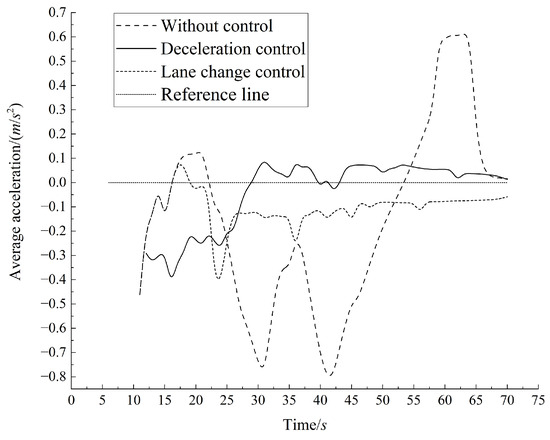
Figure 11.
Comparison of average acceleration of subsequent traffic flow under different control.
Regarding the merging and lane-changing time, by implementing speed reduction decision control on the cooperating vehicle m3, it is found that the merging and lane-changing time of the ramp vehicle r is reduced by 13 s compared to no control conditions, from 36 s to 23 s, a reduction of 36.11%, significantly improving the merging efficiency of the ramp vehicle.
As shown in Figure 12, the solid line represents the longitudinal position trajectory of the ramp vehicle after control is implemented, while the dashed line represents the longitudinal trajectory of the ramp vehicle without control. The trajectories coincide when the ramp vehicle has not yet reached the coordination area. Since the longitudinal position of the main lane 1 in the constructed merging area scenario is −4.8 m, the ramp vehicle reaching this position indicates the completion of the merging and lane-changing process. The figure shows that the ramp vehicle under control can merge and change lanes in 23 s, with a travel time of 3 s on the acceleration lane. In contrast, the ramp vehicle without control takes 36 s to merge, with a travel time of 16 s on the acceleration lane, during which it may stop and wait. Therefore, implementing strategic control can effectively reduce the merging and lane-changing time of the target ramp vehicle and decrease the dwell time on the acceleration lane.

Figure 12.
Comparison diagram of longitudinal track of target ramp vehicles with or without control decision.
Significant changes in the acceleration of the ramp vehicle and the cooperating vehicle were also observed before and after the implementation of the joint coordination strategy control, as shown in Figure 13. For the ramp vehicle, without control, due to insufficient merging space among the main road vehicles, the acceleration of the ramp vehicle fluctuates significantly, leading to unstable driving conditions. After control is implemented, with the availability of merging space, the acceleration of the ramp vehicle on the acceleration lane stabilizes and accelerates into the main line with minimal changes, significantly improving the stability of the vehicle’s movement. Similarly, for the cooperating vehicle, without control, due to the interference of the ramp vehicle’s merging intention, the cooperating vehicle must constantly monitor the ramp vehicle’s movements, resulting in significant fluctuations in acceleration. After control is implemented, the cooperating vehicle decelerates according to the prescribed deceleration rate in advance and travels to the merging area, where the ramp vehicle merges smoothly. The acceleration of the cooperating vehicle remains stable around 0 with relatively minor fluctuations, resulting in a relatively small impact and improved vehicle stability.
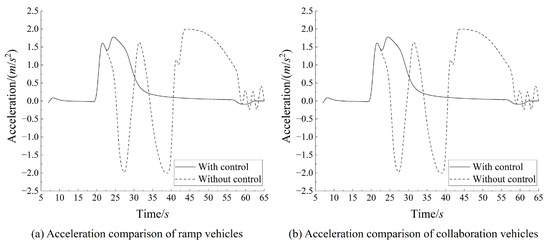
Figure 13.
Acceleration comparison diagram of main vehicles before and after control: (a) acceleration comparison of ramp vehicles; (b) acceleration comparison of collaboration vehicles.
A systematic analysis was conducted to investigate the impact of CAV penetration rates on merging strategy implementation in mixed traffic flows. The traffic composition, comprising both CAVs and HDVs, was parameterized with varying CAV penetration ratios pw. Sensitivity analysis was subsequently performed to evaluate control effectiveness under different CAV proportions (pw = 0, 0.5, and 1). Comparative vehicle speed-position profiles were generated through numerical simulations, as demonstrated in Figure 14.

Figure 14.
Comparative speed-position distributions under varied CAV penetration rates.
As illustrated in Figure 14a, significant speed variations were observed in the merging zone (400–600 m road section) while CAV penetration pw equals 0. The predominance of blue-shaded low-speed regions (5.7–9.08 m/s) indicates frequent deceleration patterns and suboptimal merging efficiency. In Figure 14b, when CAV penetration pw equals 0.5, a reduction in blue-shaded low-speed areas was observed, with incomplete merging maneuvers persisting in localized zones, demonstrating partial efficiency improvement. In Figure 14c, when CAV penetration pw equals 1, it reveals stabilized velocity profiles characterized by minimized speed fluctuations and elimination of abrupt deceleration events, achieving optimal merging efficiency. Therefore, vehicle speed stability was progressively enhanced with increasing CAV penetration rates, confirming the improved control effectiveness of the coordinated merging strategy.
In terms of energy conservation and emission reduction, the cumulative fuel consumption and pollutant emissions of vehicles in the control area during the simulation period are compared in Table 3 below. The results indicate that, in terms of fuel economy, the cumulative fuel consumption, NOx emissions, PMx emissions, and CO2 emissions with the implementation of the merging control strategy are reduced by 6.32%, 9.42%, 8.37%, and 9.37%, respectively, compared to the uncontrolled merging scenario. It is concluded that the merging strategy proposed in this paper has certain advantages in fuel economy compared to the uncontrolled situation, as illustrated in Figure 15.

Table 3.
Comparison of vehicle cumulative fuel consumption and related pollutant emissions.
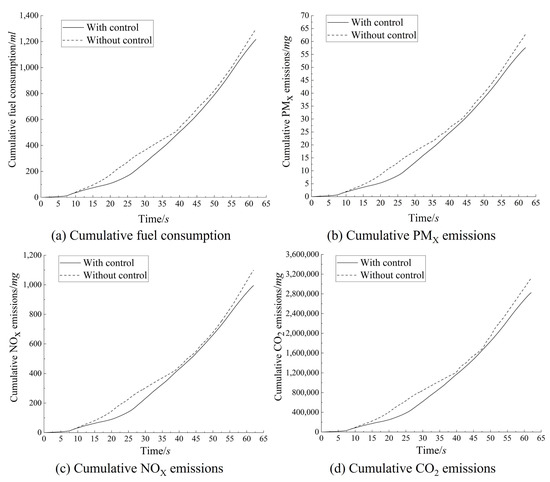
Figure 15.
Comparison of energy consumption evaluation results under different control strategies: (a) cumulative fuel consumption; (b) cumulative PMX emissions; (c) cumulative NOX emissions; (d) cumulative CO2 emissions.
Regarding travel delays, this simulation characterizes total delays by accumulating the delays of individual vehicles and measures them by comparing the actual time taken for vehicles to reach their destination after implementing/not implementing the merging strategy with the time taken under uncongested conditions. The delay results are compared in Figure 16.
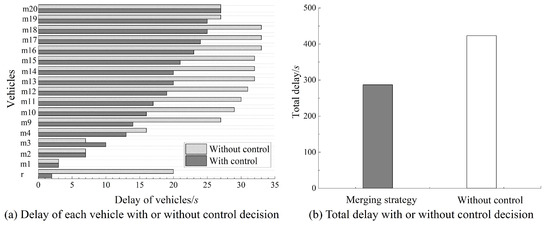
Figure 16.
Comparison of delay results with or without control decision: (a) delay of each vehicle with or without control decision; (b) comparison of total delay with or without control decision.
Figure 16a shows the individual vehicle delays with and without the merging control scheme. As can be seen from the figure, the target ramp vehicle experiences a 20 s delay when the merging strategy is not implemented, primarily due to the ramp vehicle decelerating and waiting on the acceleration lane while searching for merging space. However, after implementing the merging strategy, the delay is only 2 s, nearly achieving the requirement of unimpeded merging. For the cooperating vehicle, the delay without implementing the strategy is relatively small because the merging of the ramp vehicle changes the travel sequence of the main line vehicles. However, as shown in Figure 16b, the total delay with the merging strategy is significantly less than that without the merging strategy. The delay is reduced by 32.15% when the control strategy is implemented compared to the uncontrolled situation.
In summary, the merging strategy proposed in this study has demonstrated notable adaptability in heterogeneous traffic environments. This methodological framework holds significant potential for implementation in freeway traffic management systems, particularly in enhancing nodal operational efficiency, safety performance, and environmental sustainability across transportation networks. Future research and practical applications should prioritize the development of an extensible decision-making architecture through parametric modeling of CAV penetration rates and systematic incorporation of human driver behavioral parameters.
6. Conclusions
This paper proposes a typed collaborative merging strategy for a new hybrid traffic flow environment. The first stage of this strategy involves determining the optimal cooperating vehicle and obtaining the pairing type between the cooperating vehicle and the ramp vehicle. The second stage involves establishing different merging strategies: joint coordination merging strategy, partial collaborative merging strategy, and seeking speed limit strategy for adjacent and self-owned vehicles, with different strategies selected based on the pairing type. The third stage involves making decisions between deceleration and lane-changing schemes, selecting the best scheme for implementation, and achieving collaborative control between the cooperating vehicle and the ramp vehicle. The main conclusions of this paper are as follows:
- (1)
- Compared to the uncontrolled strategy, the proposed collaborative control strategy can reduce cumulative fuel consumption by 6.32%, NOx emissions by 9.42%, CO2 emissions by 9.37%, and total vehicle delay by 32.15%. Additionally, the merging and lane-changing time for ramp vehicles is shortened by 36.11%. This strategy can effectively reduce merging delays while ensuring vehicle safety and stability.
- (2)
- Both the lane-changing strategy and the deceleration strategy can cause disturbances to upstream vehicles. The acceleration fluctuations caused by these two schemes range from −0.5 m/s2 to −0.07 m/s2 and from −0.2 m/s2 to 0.1 m/s2, respectively, with relatively small fluctuations that meet the requirements for vehicle travel safety.
The primary objective of this study was focused on developing vehicle merging strategies in mixed traffic environments. However, simplified behavioral assumptions regarding HDVs were identified as a critical limitation, failing to adequately address the inherent unpredictability of HDV operations. Future research should prioritize the following directions: (1) The stochastic characteristics of driver behavior should be systematically investigated to develop a simulation model capable of precisely estimating driving maneuvers. This modeling framework will be specifically designed to mitigate the stochastic impacts of behavioral uncertainties on traffic state evolution through enhanced vehicle control strategies. (2) Behavioral optimization of HDV drivers to enhance compliance with recommended speed profiles. (3) Systematic integration of transient characteristics in information transmission and real-time HDV data collection mechanisms into simulation frameworks. (4) The safety and adaptability characteristics exhibited by merging strategies in mixed traffic environments should be thoroughly investigated. These methodological improvements are essential for quantitatively analyzing driver unpredictability and optimizing traffic operational efficiency in freeway merging zones.
Author Contributions
Conceptualization, Z.L.; methodology, Z.L.; software, Z.L., X.L. and Q.L.; validation, Z.L., Z.Z. and F.T.; formal analysis, Z.L. and C.G.; investigation, Z.L.; resources, X.L.; data curation, F.T.; writing—original draft preparation, X.L.; writing—review and editing, Z.L., F.T. and Q.L.; visualization, Z.Z., C.G.; supervision, Z.L., F.T. and C.G.; project administration, Z.L.; funding acquisition, Z.L. All authors have read and agreed to the published version of the manuscript.
Funding
This work was supported by the National Natural Science Foundation of China (Grant No. 52302385, awarded to Z.L.; Grant No. 52302429, awarded to F.T.), the Open Fund of Hunan International Scientific and Technological Innovation Cooperation Base of Advanced Construction and Maintenance Technology of Highway (Changsha University of Science & Technology) (Grant No. kfj220802, awarded to Z.L.), the Scientific Research Fund of Hunan Provincial Education Department (Grant No. 22B0325, awarded to F.T.) and the Hunan Provincial Natural Science Foundation (Grant No. 2024JJ6038, awarded to F.T.).
Institutional Review Board Statement
Not applicable.
Informed Consent Statement
Not applicable.
Data Availability Statement
The data used to support the findings of this study are available from the corresponding author upon request.
Conflicts of Interest
The authors declare no conflicts of interest.
References
- Liu, Z.; Chen, H.; Liu, E.; Zhang, Q. Evaluating the dynamic resilience of the multi-mode public transit network for sustainable transport. J. Clean. Prod. 2022, 348, 131350. [Google Scholar] [CrossRef]
- Li, Y.; Nan, S.-R.; Guo, Y.; Zhu, C.-H.; Li, D. Detection and analysis of transfer time in urban rail transit system using WIFI data. Transp. Lett. Int. J. Transp. Res. 2023, 15, 634–644. [Google Scholar]
- Pan, C.; Li, Y.; Wang, J.; Liang, J.; Ho, J. Research on multi-lane energy-saving driving strategy of connected electric vehicle based on vehicle speed prediction. Green Energy Intell. Transp. 2023, 2, 100127. [Google Scholar] [CrossRef]
- Wang, Y.; Hu, Z.; Lou, S.; Lv, C. Interacting multiple model-based ETUKF for efficient state estimation of connected vehicles with V2V communication. Green Energy Intell. Transp. 2023, 2, 100044. [Google Scholar] [CrossRef]
- Zhu, L.; Lu, L.; Wang, X.; Jiang, C.; Ye, N. Operational Characteristics of Mixed-Autonomy Traffic Flow on the Freeway with On- and Off-Ramps and Weaving Sections: An RL-Based Approach. IEEE Trans. Intell. Transp. Syst. 2022, 23, 13512–13525. [Google Scholar] [CrossRef]
- Jiang, C.; Yin, S.; Yao, Z.; He, J.; Jiang, R.; Jiang, Y. Safety evaluation of mixed traffic flow with truck platoons equipped with (cooperative) adaptive cruise control, stochastic human-driven cars and trucks on port freeways. Phys. A-Stat. Mech. Its Appl. 2024, 643, 129802. [Google Scholar]
- Jiang, C.; Bhat, C.R.; Lam, W.H.K. A bibliometric overview of Transportation Research Part B: Methodological in the past forty years (1979–2019). Transp. Res. Part B-Methodol. 2020, 138, 268–291. [Google Scholar] [CrossRef]
- Liu, Z.; Chen, H.; Liu, E.; Hu, W. Exploring the resilience assessment framework of urban road network for sustainable cities. Phys. A-Stat. Mech. Its Appl. 2022, 586, 126465. [Google Scholar]
- Liu, Z.; Sun, D.; Chen, H.; Hao, W.; Wang, Z.; Tang, F. Resilience-based post-disaster repair strategy for integrated public transit networks. Transp. B-Transp. Dyn. 2024, 12, 1–25. [Google Scholar] [CrossRef]
- Long, X.; Mao, J.; Qiao, Z.; Li, P.; He, W. Reinforcement learning of route choice considering traveler’s preference. Transp. Lett. Int. J. Transp. Res. 2024, 16, 658–671. [Google Scholar] [CrossRef]
- Peng, Z.; Pan, H.; Yuan, R.; Wang, Y. A comparative analysis of risk factors influencing crash severity between full-time and part-time riding-hailing drivers in China. Transp. Lett. Int. J. Transp. Res. 2024, 6, 1545411. [Google Scholar] [CrossRef]
- Ramezani, M.; Ye, E. Lane density optimisation of automated vehicles for highway congestion control. Transp. B-Transp. Dyn. 2019, 7, 1096–1116. [Google Scholar] [CrossRef]
- Ntousakis, I.A.; Nikolos, L.K.; Papageorgiou, M. Optimal vehicle trajectory planning in the context of cooperative merging on highways. Transp. Res. Part C-Emerg. Technol. 2016, 71, 464–488. [Google Scholar] [CrossRef]
- Lagerev, R.; Kapski, D.; Burinskiene, M.; Barauskas, A. Reducing a possibility of transport congestion on freeways using ramp control management. Transport 2017, 32, 314–320. [Google Scholar] [CrossRef][Green Version]
- Sun, J.; Zuo, K.; Jiang, S.; Zheng, Z. Modeling and Predicting Stochastic Merging Behaviors at Freeway On-Ramp Bottlenecks. J. Adv. Transp. 2018, 2018, 9308580. [Google Scholar] [CrossRef]
- Pei, H.; Feng, S.; Zhang, Y.; Yao, D. A Cooperative Driving Strategy for Merging at On-Ramps Based on Dynamic Programming. IEEE Trans. Veh. Technol. 2019, 68, 11646–11656. [Google Scholar] [CrossRef]
- Xu, L.; Lu, J.; Ran, B.; Yang, F.; Zhang, J. Cooperative Merging Strategy for Connected Vehicles at Highway On-Ramps. J. Transp. Eng. Part A-Syst. 2019, 145, 04019022. [Google Scholar]
- Ding, J.; Li, L.; Peng, H.; Zhang, Y. A Rule-Based Cooperative Merging Strategy for Connected and Automated Vehicles. IEEE Trans. Intell. Transp. Syst. 2020, 21, 3436–3446. [Google Scholar] [CrossRef]
- Kherroubi, Z.e.A.; Aknine, S.; Bacha, R. Novel Decision-Making Strategy for Connected and Autonomous Vehicles in Highway On-Ramp Merging. IEEE Trans. Intell. Transp. Syst. 2022, 23, 12490–12502. [Google Scholar] [CrossRef]
- van Beinum, A.; Hovenga, M.; Knoop, V.; Farah, H.; Wegman, F.; Hoogendoorn, S. Macroscopic traffic flow changes around ramps. Transp. A-Transp. Sci. 2018, 14, 598–614. [Google Scholar] [CrossRef]
- Guo, J.; Cheng, S.; Liu, Y. Merging and Diverging Impact on Mixed Traffic of Regular and Autonomous Vehicles. IEEE Trans. Intell. Transp. Syst. 2021, 22, 1639–1649. [Google Scholar] [CrossRef]
- Han, X.; Xu, R.; Xia, X.; Sathyan, A.; Guo, Y.; Bujanovic, P.; Leslie, E.; Goli, M.; Ma, J. Strategic and tactical decision-making for cooperative vehicle platooning with organized behavior on multi-lane highways. Transp. Res. Part C-Emerg. Technol. 2022, 145, 103952. [Google Scholar]
- Kunibe, M.; Asahina, H.; Shigeno, H.; Sasase, I. A Scheduling Scheme for Autonomous Vehicle Highway Merging with an Outflow Traffic and Fairness Analysis. IEEE Access 2021, 9, 49219–49232. [Google Scholar] [CrossRef]
- Zhao, X.; Abdo, A.; Liao, X.; Barth, M.; Wu, G. Evaluating Cybersecurity Risks of Cooperative Ramp Merging in Mixed Traffic Environments. IEEE Intell. Transp. Syst. Mag. 2022, 14, 52–65. [Google Scholar] [CrossRef]
- Scholte, W.J.; Zegelaar, P.W.A.; Nijmeijer, H. A control strategy for merging a single vehicle into a platoon at highway on-ramps. Transp. Res. Part C-Emerg. Technol. 2022, 136, 103511. [Google Scholar]
- Xue, Y.; Zhang, X.; Cui, Z.; Yu, B.; Gao, K. A platoon-based cooperative optimal control for connected autonomous vehicles at highway on-ramps under heavy traffic. Transp. Res. Part C-Emerg. Technol. 2023, 150, 104083. [Google Scholar]
- Li, H.; Xiao, T.; Li, Y.; Feng, Y. Development and safety evaluation of an adaptive personalized speed guidance system for on-ramp merging in highway service areas. Transp. Res. Part A-Policy Pract. 2024, 190, 104296. [Google Scholar]
- Wang, H.; Wang, W.; Yuan, S.; Li, X.; Sun, L. On Social Interactions of Merging Behaviors at Highway On-Ramps in Congested Traffic. IEEE Trans. Intell. Transp. Syst. 2022, 23, 11237–11248. [Google Scholar] [CrossRef]
- Yang, L.; Park, D.; Lyu, S.; Kim, T.; Kim, N. Analysis of the Impact of Speed Trajectory Optimization on Energy Consumption During Highway Merging. IEEE Access 2024, 12, 173243–173254. [Google Scholar] [CrossRef]
- Aramrattana, M.; Larsson, T.; Englund, C.; Jansson, J.; Nabo, A. A Simulation Study on Effects of Platooning Gaps on Drivers of Conventional Vehicles in Highway Merging Situations. IEEE Trans. Intell. Transp. Syst. 2022, 23, 3790–3796. [Google Scholar] [CrossRef]
- Chen, D.; Hajidavalloo, M.R.; Li, Z.; Chen, K.; Wang, Y.; Jiang, L.; Wang, Y. Deep Multi-Agent Reinforcement Learning for Highway On-Ramp Merging in Mixed Traffic. IEEE Trans. Intell. Transp. Syst. 2023, 24, 11623–11638. [Google Scholar] [CrossRef]
- He, X.; Lou, B.; Yang, H.; Lv, C. Robust Decision Making for Autonomous Vehicles at Highway On-Ramps: A Constrained Adversarial Reinforcement Learning Approach. IEEE Trans. Intell. Transp. Syst. 2023, 24, 4103–4113. [Google Scholar] [CrossRef]
- Wei, C.; He, Y.; Tian, H.; Lv, Y. Game Theoretic Merging Behavior Control for Autonomous Vehicle at Highway On-Ramp. IEEE Trans. Intell. Transp. Syst. 2022, 23, 21127–21136. [Google Scholar] [CrossRef]
- Rios-Torres, J.; Malikopoulos, A.A. Automated and Cooperative Vehicle Merging at Highway On-Ramps. IEEE Trans. Intell. Transp. Syst. 2017, 18, 780–789. [Google Scholar] [CrossRef]
- Rios-Torres, J.; Malikopoulos, A.A. A Survey on the Coordination of Connected and Automated Vehicles at Intersections and Merging at Highway On-Ramps. IEEE Trans. Intell. Transp. Syst. 2017, 18, 1066–1077. [Google Scholar] [CrossRef]
- Wang, H.; Yuan, S.; Guo, M.; Li, X.; Lan, W. A deep reinforcement learning-based approach for autonomous driving in highway on-ramp merge. Proc. Inst. Mech. Eng. Part D-J. Automob. Eng. 2021, 235, 2726–2739. [Google Scholar]
- Chen, N.; van Arem, B.; Alkim, T.; Wang, M. A Hierarchical Model-Based Optimization Control Approach for Cooperative Merging by Connected Automated Vehicles. IEEE Trans. Intell. Transp. Syst. 2021, 22, 7712–7725. [Google Scholar] [CrossRef]
- Chen, N.; van Arem, B.; Wang, M. Hierarchical Optimal Maneuver Planning and Trajectory Control at On-Ramps with Multiple Mainstream Lanes. IEEE Trans. Intell. Transp. Syst. 2022, 23, 18889–18902. [Google Scholar] [CrossRef]
- Cheng, M.; Zhang, C.; Jin, H.; Wang, Z.; Yang, X. Adaptive Coordinated Variable Speed Limit between Highway Mainline and On-Ramp with Deep Reinforcement Learning. J. Adv. Transp. 2022, 2022, 2435643. [Google Scholar] [CrossRef]
- Li, G.; Zhao, L.; Tang, W.; Wu, L.; Ren, J. Modeling and analysis of mandatory lane-changing behavior considering heterogeneity in means and variances. Phys. A-Stat. Mech. Its Appl. 2023, 622, 128825. [Google Scholar]
- Li, M.; Li, Z.; Wang, S.; Zheng, S. Enhancing Cooperation of Vehicle Merging Control in Heavy Traffic Using Communication-Based Soft Actor-Critic Algorithm. IEEE Trans. Intell. Transp. Syst. 2023, 24, 6491–6506. [Google Scholar] [CrossRef]
- Pang, M.; Huang, J. Cooperative Control of Highway On-Ramp with Connected and Automated Vehicles as Platoons Based on Improved Variable Time Headway. J. Transp. Eng. Part A-Syst. 2022, 148, 04022034. [Google Scholar]
- Shi, J.; Li, K.; Chen, C.; Kong, W.; Luo, Y. Cooperative Merging Strategy in Mixed Traffic Based on Optimal Final-State Phase Diagram With Flexible Highway Merging Points. IEEE Trans. Intell. Transp. Syst. 2023, 24, 11185–11197. [Google Scholar] [CrossRef]
- Liu, H.; Zhuang, W.; Yin, G.; Li, Z.; Cao, D. Safety-Critical and Flexible Cooperative On-Ramp Merging Control of Connected and Automated Vehicles in Mixed Traffic. IEEE Trans. Intell. Transp. Syst. 2023, 24, 2920–2934. [Google Scholar] [CrossRef]
- Sonbolestan, M.-R.; Monajjem, S.; Rouhani, E. Impact of Optimal Selection of Merging Position on Fuel Consumption at Highway On-Ramps. J. Transp. Eng. Part A-Syst. 2021, 147, 04021023. [Google Scholar]
- Wang, G.; Jia, H.; Feng, T.; Tian, J.; Li, M.; Wang, L. An acceptability-based multi-objective traffic flow adjustment method for environmental sustainability and equity. J. Clean. Prod. 2023, 418, 138077. [Google Scholar] [CrossRef]
Disclaimer/Publisher’s Note: The statements, opinions and data contained in all publications are solely those of the individual author(s) and contributor(s) and not of MDPI and/or the editor(s). MDPI and/or the editor(s) disclaim responsibility for any injury to people or property resulting from any ideas, methods, instructions or products referred to in the content. |
© 2025 by the authors. Licensee MDPI, Basel, Switzerland. This article is an open access article distributed under the terms and conditions of the Creative Commons Attribution (CC BY) license (https://creativecommons.org/licenses/by/4.0/).